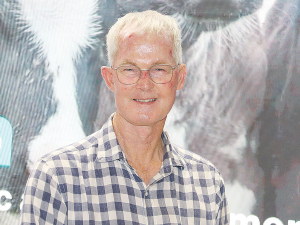Primary exports hit new high
NZ primary exports are set to reach almost $60 million in the year ended 30 June 2025.
 DairyNZ chair Jim van der Poel says the latest report shows NZ still relies on agriculture for its wealth.
DairyNZ chair Jim van der Poel says the latest report shows NZ still relies on agriculture for its wealth.
While the numbers in the SOPI report look good and there are positive signs, there are also some headwinds.
The SOPI report singles out the weak NZ dollar as a significant contributor to the good result, saying this has helped offset some of the recent lower prices for our products.
It points to a slowdown of the global economy due to inflation pressure, the Russia/Ukraine conflict and China.
The latter is a big worry because it accounts for a large percentage of our exports.
The report notes that China’s goal of containing Covid-19 appears to have come at a significant economic expense – especially in the second quarter of 2022. It says mobility restrictions have depressed demand and affected supply chains.
On the other hand, it says there are signs of an improvement in shipping times and port delays.
On the home front, the report picks up on the impact of erratic La Nina weather patterns and the affect this has had on pasture growth and in turn milk production. It also highlights its severe impact on the horticulture sector, which has seen crops ruined by floodwaters and caused delays in the planting of other crops such as maize.
Another big concern is the sharp rise in farm expenses. The SOPI report notes the farm expenses price index has increased by 15% in the year to the end of September 2022.
All of this, it would appear, will see farm profits reduced in real terms in the coming 12-months.
For meat there are pluses and minuses. MPI says weaker purchasing power in key markets is likely to put downward pressure on prices as consumers adjust their budgets to the global economic downturn. It notes that sheepmeat and beef prices are already starting to weaken, but adds that with global meat supplies running tight, this may prevent a substantial fall in prices.
The news for dairy is better with the outlook for the coming year good and a suggestion that with the warm weather, pasture growth is picking up and milk production may do the same.
DairyNZ chair Jim van der Poel says the latest SOPI report shows that NZ still relies on the agricultural sector for its wealth.
He pointed out the significance of the fact that more than 80% of NZ’s export earnings come from the ag sector and, despite the challenges in front of the sector, its contribution continues to grow and be the major contributor to our export earnings.
Van der Poel says dairy exports make it possible for Kiwis to buy cars and medicines and all the items that people take for granted. He says if wasn’t for the dairy industry the country would be a very different place.
“People don’t connect the dots and realise this,” he says.
Engaging, thought provoking speakers, relevant seminars and relatable topics alongside innovative produces and services are the order of the day at the 2026 East Coast Farming Expo.
Farm supplies trader Ruralco has recovered from two consecutive years of losses to post a $1.25 million profit for the 2025 financial year.
Naki Honey, a New Zealand manuka apiary company, has crafted what is believed to be the world's most expensive honey.
OPINION: Wool farmers believe the future of strong wool still holds promise.
Applications are open for Horticulture New Zealand's (HortNZ) 2026 scholarship programme, with 20 funding opportunities available.
OPINION: Farmers are being asked to celebrate a target that changes nothing for the climate, wastes taxpayer money, and ignores real science.